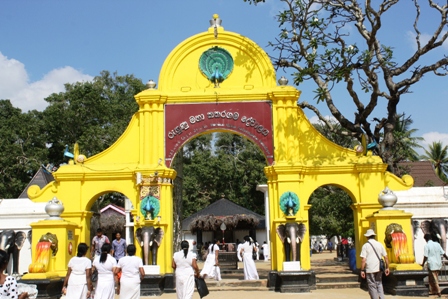Sri Lanka 2013
Episode 4: Puja Lineup in Kataragama Temple
Click the photo above to see an album of photos. Close the window to return to this page
Read Previous Episode 3: Yala NP or Next Episode 5: Ella
|
January 15 2013 Tissa
There is more than one reason to explore the region around
Tissa. Kataragama, 15 km northeast of Tissa, is the most
important pilgrimage site, along with Adam’s Peak, in Sri Lanka.
The town is holy to Hindus, Buddhists and Muslims. The site is
ancient. A shrine to the resident deity, Kataragama Deviyo, was
built by the Sinhalese king in the 2ndcentury
BC and the Buddhist temple or dagoba, Kirivehera, dates back to
the 1stcentury
BC. We were advised to attend one of the three puja ceremonies
held each day at the Hindu Maha Devale complex to witness the
colourful ceremonies of the devout. We chose the 10:30 AM
ceremony, after which we could explore as much of the other
shrines as we wanted.
It was just a short 20 minute bus ride from our hotel in Tissa. We knew we were in for a safe ride as the bus driver was protected by a row of eight Hindu gods and one Buddha arranged above the driver’s head, each deity sporting a flashing halo of coloured lights. Once in Kataragama, we headed through a market area to a bridge spanning the Menik Ganga River. Several pilgrims were standing in the muddy, brown water at the foot of broad stairs, lathering themselves with soap before heading to the shrines. Grey langur monkeys, the same kind we saw the day before in Yala, make Katagama their home, perching on the tops of the temples and scampering across the roads. Pilgrims were already amking their way to the Maha Devale complex, so we followed them. The pilgrims were heading for the complex of three small shrines, Kirivehara dedicated to the Buddha, Sivam Kovil dedicated to Ganesh, the elephant god , and the most important, Maha Devale, where the biggest ceremonies are held. The Pilgrims lined up at the Maha Devale shrine, many carrying large arrangements of fruit as offerings to be blessed in the puja ceremony and offered as gifts to the gods. Ray and I first explored the other small shrines and Bodhi tree, revered by Buddhists. When the priests rang the two bells outside the shrine at 10:30, signalling the start of the ceremonies, the first group of pilgrims filed into the shrine. There were still enough pilgrims in the lineup outside to fill the shrine at least one more time, but they were not concerned. We watched from outside as priests carried religious articles used in the ceremony into the shrine. More bells were rung and trumpets blown. At the end of half an hour the first batch of pilgrims exited and the next batch readied themselves for their turn. We went into the Sivam Kovil shrine where for a small donation my forehead was painted with a red dot of paint. I was pujad. Devotees were offered a handful of lentil curry and rice, but I did not ask for any. We were then encouraged to go inside the Maha Devale shrine to see the depictions of the 12-armed Hindu war god, Murugan, who is considered the same as the resident deity, Kataragama Deviyo. Leaving the Hindu temples, we walked through parkland to Kirivehara, a large white Buddhist temple surrounded by small Buddha shrines. We recognized several of the pilgrims who had finished their devotions at the Hindu temple. Perhaps they we hedging their bets by worshipping at the Buddhist site as well. It was time to find a restaurant for lunch before heading back on the bus to Tissa. We walked back to bridge across the Menik Ganga just in time to watch mahoots bring three elephants down for their daily bath in the river. The elephants are often used as part of the ceremonies at Maha Devale, but today must have been their day off. We chose a Chinese restaurant for lunch that offered, not Chinese food, but a typical Sri Lankan buffet of various curries and rice. It was very cheap and quite good. Later that afternoon we took a short walk past Tissa Wewa, a large man-made lake, to see the fruit bats in the trees amongst a sea of water lilies beside the lake. Several men were fishing from the path alongside the lake and others were carrying trays of dried fish to sell. We found the fruit bats, hanging from the top limbs of several trees at the side of the lake. Some were starting to move, stretching their wings, in readiness for their evening foray looking for a meal of mosquitoes and other tasty treats. Egrets, herons and storks were starting to take their night time posts at the tops of the same trees. A few locals on bicycles directed us to one tree a short distance from the road where a crocodile lay, watched by a few herons. We decide not to wait until dark to see the fruit bats take off. We just walked back to our hotel to relax before dinner. Read Previous Episode 3: Yala NP or Next Episode 5: Ella Read India 2013 Return to Sri Lanka Intro Return to Travels or Introduction |
